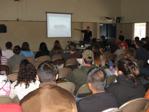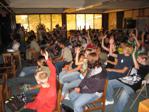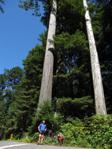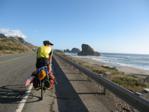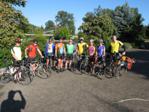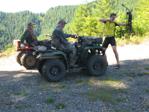When I was thinking about taking on this project and the USA bicycle tour, someone told me: If you want to hate this country read the newspaper every day; if you want to love this country ride a bicycle across it. They were certainly right about the second part. We live in a country with exquisite physical beauty and amazing human diversity of all kinds. I encourage you to go see it along the back roads at ten miles per hour. It will give you hope.
Ride for Climate is simply a few people who took a bit of their time to tell people about a large problem and encourage action on solutions to the problem. The bulk of the work was done by a handful of people. Many other people supported us along the way. We gave over 45 public talks, kept a website, and reached thousands of other people through newspaper, radio and TV interviews. Anyone could do something similar. It was a lot of work, but a lot of fun too. I’m fairly certain that in 40 years I won’t look back and say “I wish I had done something else with that year of my life.”
One of the most striking things to me on this journey was the interest in enacting solutions to global warming once people understood the nature of the problem and the kinds of solutions that are available to us. When given good information about the problem, the vast majority of people wanted significant action. Yet, too often people were happy that someone else was taking action and speaking out without recognizing their personal responsibility to make changes in their own life and lifestyle. Too many people are still waiting for someone else to come to the rescue without recognizing that each of us can and must be a part of the solution.
Along the journey some people have posed the question “who is your target audience?” You are. Have you changed out a few light bulbs? Great — change out all of them. Have you purchased a more fuel efficient vehicle? Excellent — try to leave it parked a couple days a week and find alternative ways to get to work. Have you written to your legislators to tell them that they need to promote solutions to global warming? Don’t wait; do it today.
Some people say that personal action — changing a light bulb or getting a home energy audit — has far too little impact to address this problem. They are certainly correct — we will need to make significant policy changes and changes in the way we create and use energy if we are going to reduce our carbon dioxide emissions by what scientists say is needed — at least 80% by 2050. But all of these larger changes begin with individual action — the action of a student, a soccer mom, a business leader, a politician. Don’t underestimate that first small step. A friend of mine emailed recently to tell us a story. We stopped at the summer camp she helps to run and gave a talk to the kids. One of the kids, she told us, returned home after camp to find that a new coal power plant is proposed on the Zuni reservation where she lives. She has taken it upon herself to organize a campaign to fight this new coal power plant.
We have a choice — we can have a world that is a little bit hotter or one that is a lot hotter. Science tells us that the planet will warm in the next century, but whether it warms a couple degrees or many degrees depends largely on how much carbon dioxide we put into the atmosphere through burning fossil fuels. Our actions in the coming years will determine if we give our children a healthy planet or one with a dangerously high fever. It is our choice.

I had never done a bicycle tour before this one. On April 21st, I started this bicycle tour with a ride of 60 miles. That night, tired and very sore, I looked at a map of the USA and saw how little of the ride I had completed and how incredibly far I had left to go. It felt impossible. Yet, the next day we rode 60 miles and then again the day after that. Now, five months later, I have crossed the USA and what is most apparent is not how difficult it was, but how easy it was. And so it is. Take action — you will find it is easy and it will make you happy. You’ll have something to tell your grandkids.
A few weeks ago I attended the wedding of two very close friends. On their wedding program was this poem. It seems like an appropriate way to end this portion of the journey.
In the next century
or the one beyond that,
they say,
are valleys, pastures.
We can meet there in peace
if we make it.
To climb these coming crests
one word to you, to
you and your children:
stay together
learn the flowers
go light
~Gary Snyder










